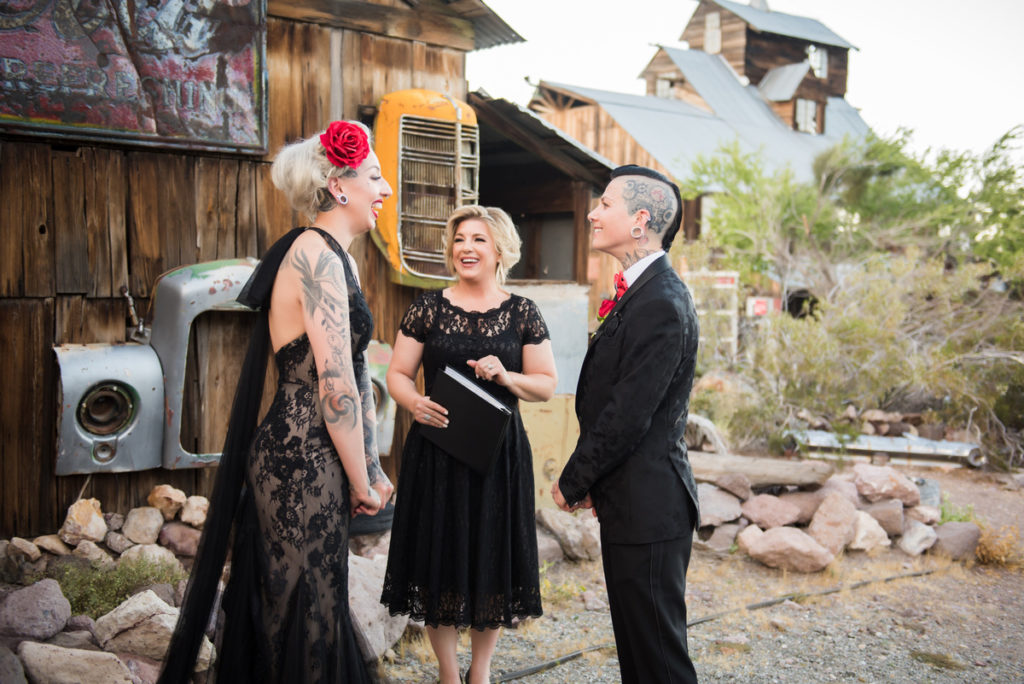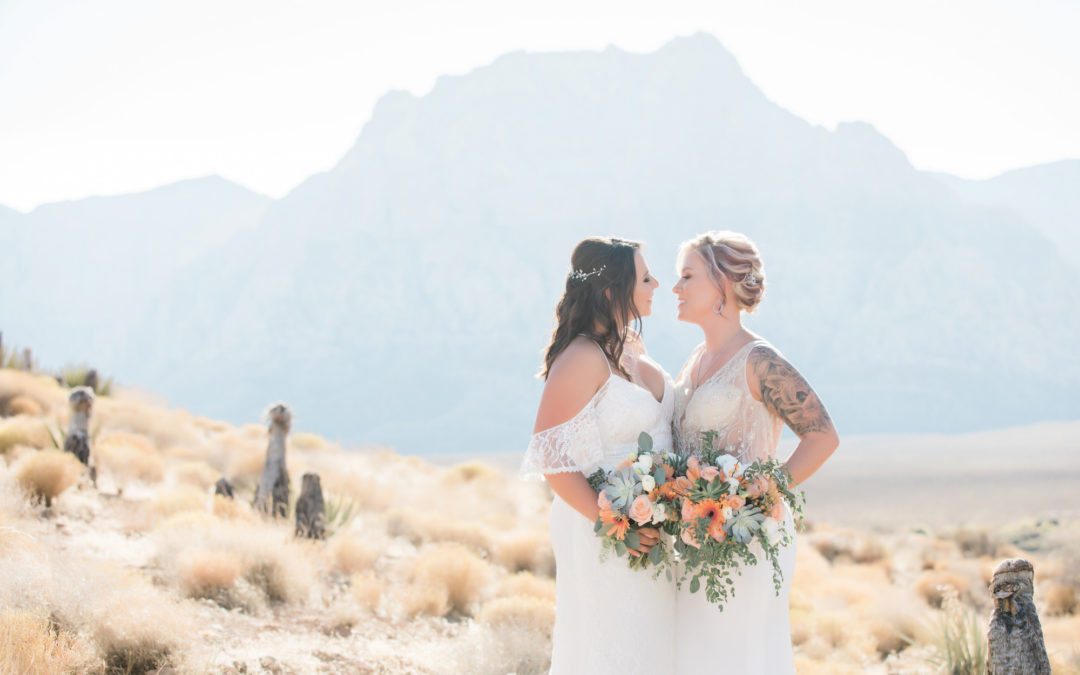Disclosure: This post may contain affiliate links. Please see our full disclaimer to learn more.
Typical wedding traditions tend to be swimming in gender-normative standards. While the world is progressing, some outdated wedding traditions and habits are unfortunately dying hard. However, with LGBTQ+ weddings becoming a new normal in their own right these traditions are progressing. Planning a gender-neutral wedding ceremony focuses on celebrating the couple as they are while leaving all of the unnecessary gender-normative traditions behind.
A gender-neutral wedding ceremony may be celebrating a LGBTQ+ couple, but that’s not a requirement. Hosting a gender-neutral wedding ceremony can also simply make your guests more comfortable by taking gender norms out of the equation. With less focus on gender, there’s more room to focus on the individual and creating a special experience.
We at Cactus Collective Weddings celebrate love and all kinds of it! Gender-neutral ceremonies, LGBTQ+ weddings, and traditional celebrations let us make your day completely personal. It’s your day, and we’re here to make your dreams come true.
Here are 7 ideas we have for planning a perfect gender-neutral wedding:
1. A gender-neutral wedding outfit can be whimsical, classic, sophisticated, edgy or whatever style really speaks to you.
A long cape-style jacket and pants set is a dramatic gender-neutral wedding outfit that really appeals to those with sophisticated and theatrical styles. For those who wish to keep their look more traditional, a custom designed two-piece suit with pants and a vest is a striking and memorable look.

2. Keeping your terminology gender-neutral is a simple yet powerful way to ensure an inclusive celebration.
Instead of bridal, use the term wedding. Instead of bridesmaids or groomsmen, use the term attendants. Ladies and gentlemen can be easily replaced with everyone, folks or friends. Bachelor and bachelorette can become bachelorx (pronounced bachelor-ex.) And bride and groom can be simply switched to spouses.
Focusing on gender-neutral terminology creates a safe and welcoming atmosphere for all!
| GENDERED | GENDER NEUTRAL |
| Bride | Marrier or celebrant or their name |
| Groom | Marrier or celebrant or their name |
| Couple | Partners or marriers |
| Bridal | Wedding |
| Bridal suite | Wedding suite |
| Bridal party | Wedding party, crew |
| Bridesmaids | Attendants |
| Groomsmen | Attendants |
| Maid/Matron of Honor | Person of Honor, Attendant, Honor Attendant |
| Best Man | Person of Honor, Attendant, Honor Attendant |
| Flower girl | Flower child |
| Ring bearer | Junior attendant |
| Fiancé/Fiancée | Nearlywed, Intended, Spouse-to-be |
| Husband | Spouse or partner |
| Wife | Spouse or partner |
| Mother/father | Parent or caregiver |
| Brother/sister | Sibling |
| Ladies/guys/girls (when greeting a group) | Hey everyone, folks, y’all, friends, or people |
| Ma’am/sir/gentlemen (when addressing guests) | Simply say “excuse me” or pardon me” |
| Bridal shower | Wedding shower or couple’s shower |
| Bachelor party | Bach party |
| Bachelorette party | Bach party |
| Bridal show/expo | Wedding show/expo |
| Father-daughter dance/Mother-son dance | Special dances |
| Groom’s cake | Second cake |
| Menswear | Suit style, formalwear |
| Bridal portraits | Portraits |
| “I now pronounce you husband and wife.” | “I now pronounce you married.” |
| “You may kiss the bride.” | “You may kiss your partner.” |
| “Please welcome for the first time, Mr. and Mrs. Smith!” | “Please welcome the happy newlyweds!” |
3. The boutonniere is an accessory that looks great in photos and works with absolutely any outfit.
Rather than deciding on corsages and boutonnieres, which are traditionally gendered, going with all boutonnieres for your flowers creates a uniform and inclusive look. Additionally, bouquets can be carried by any attendant or participant. It’s the arrangement that stands out, not the gender-normative assigned style!
4. There is no rule that dictates your processional order.
Attendants may walk with whoever you please, and no one has to “give” anyone away. One popular choice that partners are making is to meet each other before walking down the aisle hand-in-hand. One or both partners may also wish to walk with their parent or parents or all can walk together as a group.
Your procession should be about you, not gender-normative traditions!

5. The bouquet toss is rooted in about 200 years of tradition, dating all the way back to the 1800’s.
It’s a fun tradition, and it’s one that is often observed in all sorts of weddings. For a more gender inclusive take on the bouquet toss, both partners can toss their bouquet or boutonniere into their crowd of all single guests.
6. Gender-neutral restrooms make a big impact on a gender-neutral wedding ceremony.
A reception venue may have gender neutral restrooms already or the couple can ask if restrooms can be made gender-neutral for the event. For an outdoor wedding or reception, portable toilets are automatically a gender-neutral option.
7. Wedding invitations are another area where gender-normative traditions usually pop up.
Addressing invitations to “Mr.” and “Mrs.” or “Ms.” is customary but it doesn’t need to be. You may address your invitations to the individual names of your recipients, or use the gender-neutral honorific “Mx.”. instead.

Creating Your Own Wedding Traditions
Something that many couples come to learn quite quickly during the wedding planning process is how deeply rooted in gender norms many of these traditions are. For non-binary, LGBTQ+, and non-traditional couples this can be a disheartening part of what should be a truly special time. Place cards, speaking with planners, even down to the language of the DJ is rooted in gender norms.
Dismantling these gender normative traditions and rebuilding them into something entirely your own is an empowering way to celebrate your unique love! As you navigate the wedding planning process with inclusivity in mind, having professionals at your side to answer your questions puts the magic back into the experience. Our Cactus Collective Weddings team is here to support and guide you in creating the most supportive and inclusive celebration of love!
Start Planning Your Destination Wedding
McKenzi Taylor is America’s go-to elopement and micro wedding expert, often featured in small and major media outlets, such as the New York Times. With over 15 years of wedding photography experience, it was after planning her own Las Vegas elopement in 2016 that McKenzi felt her purpose shift into elopement coordination. She started Cactus Collective Weddings soon after in 2017. Since then, she’s become a WIPA board member, and has helped well over 1000 couples get hitched in style around Las Vegas, San Diego and Black Hills.


